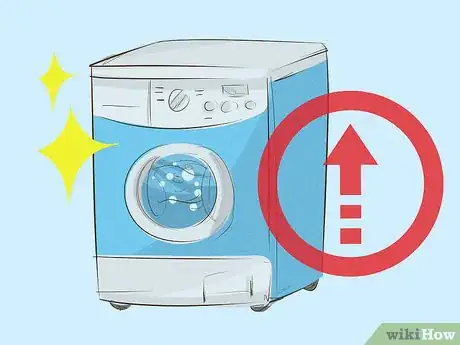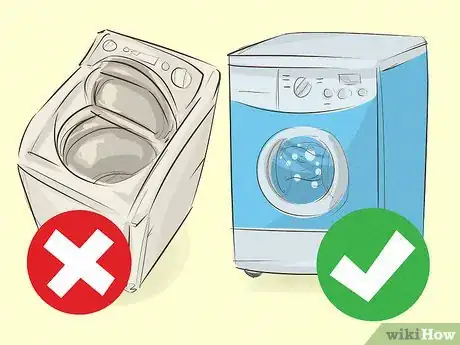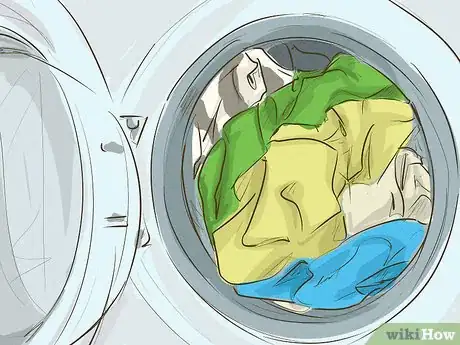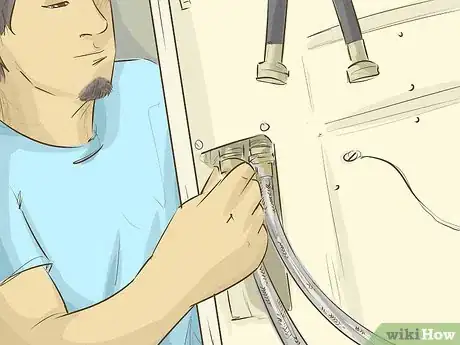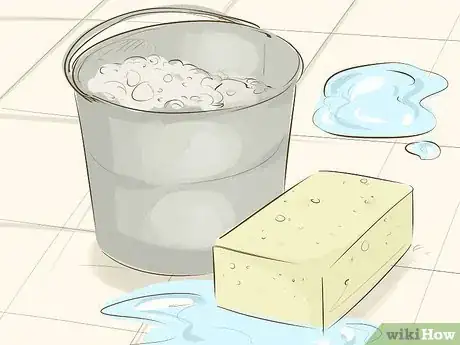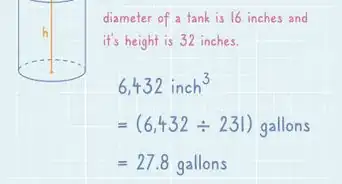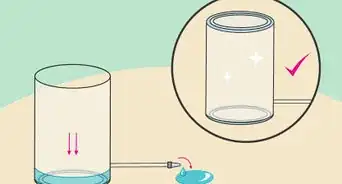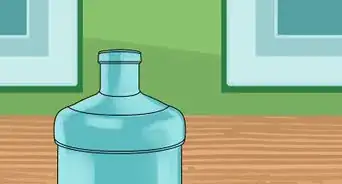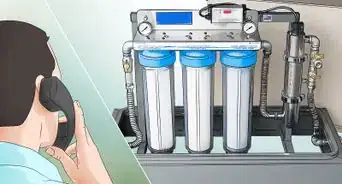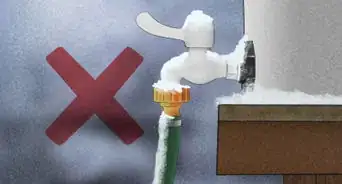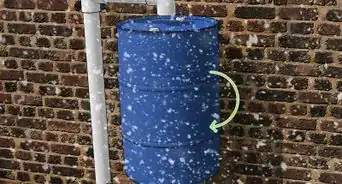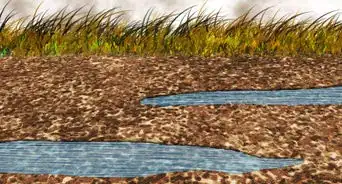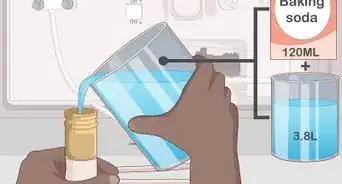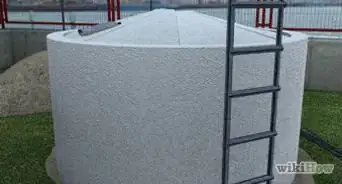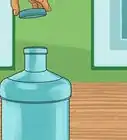This article was co-authored by Walter Brant. Walter Brant is a wikiHow community member and contributor who has been repairing and restoring houses with over 30 years of experience. He works with homeowners to make a wide variety of improvements to make their homes more comfortable and liveable.
There are 9 references cited in this article, which can be found at the bottom of the page.
This article has been viewed 31,511 times.
Many laundry room appliances use a substantial amount of water. Older models of washing machine, for example, can require as many as 50 gallons of water per washing cycle.[1] This can add considerable cost to your water bill, but beyond the expense, in arid climates where water conservation is a concern, saving water in the laundry room might be a necessity. Cut down on water usage by optimizing your clothes washing, then all you need to do is implement some water waste prevention techniques.
Steps
Optimizing Your Clothes Washing
-
1Upgrade your washing machine. When the time comes to replace your washing machine, buy a model with energy and water-saving features. In fact, newer models of washing machines are generally designed to use less water and electricity.[2]
-
2Prioritize front-load models when buying a washing machine. Top-load models of washing machine generally use much more water than front-load models. Due to improved design, front-load washing machines can save you a considerable amount of water in the laundry room with every load.[5]Advertisement
-
3Pre-treat difficult stains before washing them. Some stains may require special pre-treating techniques, but you can pre-treat most stains by saturating the stain with a stain remover. After that, rub the stain remover into the stain with your finger.
- For especially bad stains, you might need to rub the stain remover gently with a toothbrush. Brushing too hard could cause the color in the fabric to lift.[6]
- Stain remover can be found in the laundry section of most grocery stores, general retailers, and drug stores.
- Pre-treating will ensure your stains come out in the first wash cycle, which will save you from wasting water re-washing clothes.[7]
-
4Wash full loads of laundry whenever possible. Full loads of laundry maximize the water used in the washing process. By faithfully washing full loads of laundry, you could end up saving as much as 10,534 gallons of water per year.[8]
- Newer models of washing machine may have special settings that allow the amount of water used to be adjusted, allowing you to save water by matching load size with water amount.
-
5Skip additional rinse cycles. Your washer may have the option for a secondary and unnecessary rinse cycle. In many cases, this is signified by the words "Extra Rinse."[9] Turn off this feature to save your household a load of water with each complete wash cycle.
- The "Extra Rinse" cycle helps to remove detergent more thoroughly from your clothing. However, people with sensitive skin can suffer skin irritation if the Extra Rinse is skipped.
- If you have sensitive skin but still want to save water, consider using gentle, all-natural, chemical free detergents. These are gentler on the skin, and might not cause irritation when skipping the Extra Rinse cycle.[10]
Preventing Water Waste
-
1Check for and repair leaks regularly. Over time, the fittings and connectors on your pipes can come loose. Loose plumbing may allow water to drip through, which over time can create quite a bit of waste. If you see any drips or puddles in your laundry room, address them immediately. In many cases, tightening the connections with a wrench may solve your problem, though other leak fixing techniques may be required.
- Leaky plumbing, beyond contributing to water waste, can also cause significant damage to the infrastructure of your home and to your possessions as well.
- Hoses connected to your washing machine can be jostled loose sometimes, especially if you've cleaned recently. Check and re-fasten these on your washer.[11]
-
2Use basins and buckets when cleaning. When cleaning fruit, food, around the home, cloth items, and so on, you may be tempted do so with a steady stream of water straight from the faucet. While this is often most convenient, it can result in unnecessary waste.
- Add a conservative estimate of the water you need to a basin or bucket. Use this to clean, and, if necessary, add more water to the bucket little by little.[12]
-
3Direct greywater drainage to plants and trees. The term "greywater" refers to the mostly reusable water that is the byproduct of washing in sinks, tubs, washing machines, and so on. This water should not have come into contact with feces.[13] It can be a useful form of irrigation around your lawn, and can help you cut down on your sprinkler usage.[14]
- You can hire a plumber to redirect your greywater drainage directly to your lawn or garden.
Expert Q&A
Did you know you can get expert answers for this article?
Unlock expert answers by supporting wikiHow
-
QuestionHow can we save energy while doing laundry?
 Walter BrantWalter Brant is a wikiHow community member and contributor who has been repairing and restoring houses with over 30 years of experience. He works with homeowners to make a wide variety of improvements to make their homes more comfortable and liveable.
Walter BrantWalter Brant is a wikiHow community member and contributor who has been repairing and restoring houses with over 30 years of experience. He works with homeowners to make a wide variety of improvements to make their homes more comfortable and liveable.
Handyman
-
QuestionWhat washing machine uses the least water?
 Walter BrantWalter Brant is a wikiHow community member and contributor who has been repairing and restoring houses with over 30 years of experience. He works with homeowners to make a wide variety of improvements to make their homes more comfortable and liveable.
Walter BrantWalter Brant is a wikiHow community member and contributor who has been repairing and restoring houses with over 30 years of experience. He works with homeowners to make a wide variety of improvements to make their homes more comfortable and liveable.
Handyman
References
- ↑ https://www.srpwater.com/conserving-at-home.aspx#carousel-outdoors
- ↑ Walter Brant. Handyman. Expert Interview. 1 October 2020.
- ↑ Walter Brant. Handyman. Expert Interview. 1 October 2020.
- ↑ Walter Brant. Handyman. Expert Interview. 1 October 2020.
- ↑ https://www.youtube.com/watch?v=FG38Zrn_aUQ
- ↑ http://www.mamaslaundrytalk.com/how-to-pre-treat-a-stain-on-clothing/
- ↑ https://www.srpwater.com/conserving-at-home.aspx#carousel-outdoors
- ↑ http://njwatersavers.rutgers.edu/Ready%20to%20Post/Individual/Indoor/II.%20B%20Tips%20for%20saving%20water%20in%20the%20laundry%20room.pdf
- ↑ http://wateruseitwisely.com/laundryroom/
- ↑ https://www.persil.co.uk/sustainability/how-often-to-do-laundry-saving-water-in-the-laundry-room-2/
- ↑ https://www.srpwater.com/conserving-at-home.aspx#carousel-outdoors
- ↑ http://njwatersavers.rutgers.edu/Ready%20to%20Post/Individual/Indoor/II.%20B%20Tips%20for%20saving%20water%20in%20the%20laundry%20room.pdf
- ↑ http://greywateraction.org/contentabout-greywater-reuse/
- ↑ http://wateruseitwisely.com/tips/category/laundry-room/
